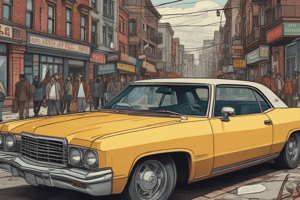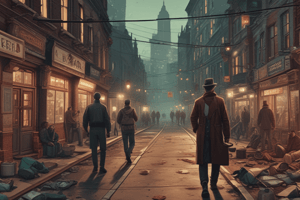Podcast
Questions and Answers
Who is considered the founder of sociological approaches to criminology?
Who is considered the founder of sociological approaches to criminology?
- Hirschi
- Robert Merton
- Émile Durkheim (correct)
- Max Weber
What does the term 'anomie' refer to in sociological theory?
What does the term 'anomie' refer to in sociological theory?
- The decrease in social cohesion
- The breakdown of societal moral values (correct)
- The increase in crime due to biological factors
- The hereditary nature of criminality
Which of the following is a general assumption of sociological approaches to crime?
Which of the following is a general assumption of sociological approaches to crime?
- Crime is a normal and functional occurrence in society (correct)
- Crime is caused solely by individual psychological factors
- Crime is a result of inherited traits
- Crime is always a response to personal failings
Strain Theory was developed as an extension of which sociological concept?
Strain Theory was developed as an extension of which sociological concept?
Which statement reflects a key belief of the Chicago School's influence on sociological criminology?
Which statement reflects a key belief of the Chicago School's influence on sociological criminology?
How do sociologists generally view the definition of 'crime'?
How do sociologists generally view the definition of 'crime'?
What aspect of society does Durkheim argue crime helps to define?
What aspect of society does Durkheim argue crime helps to define?
What does sociological theory suggest are the primary causes of crime?
What does sociological theory suggest are the primary causes of crime?
What can be a common reaction of lower-class children towards middle-class values?
What can be a common reaction of lower-class children towards middle-class values?
According to General Strain Theory, what is one of the new sources of strain introduced by Robert Agnew?
According to General Strain Theory, what is one of the new sources of strain introduced by Robert Agnew?
What does Agnew's expansion of 'positively valued goals' include?
What does Agnew's expansion of 'positively valued goals' include?
What is a key implication of the original strain theory proposed by Merton?
What is a key implication of the original strain theory proposed by Merton?
What type of stimuli does Agnew classify as sources of strain?
What type of stimuli does Agnew classify as sources of strain?
How does failure in school typically affect a student's broader life outcomes?
How does failure in school typically affect a student's broader life outcomes?
What does the term 'presentation of negative stimuli' refer to?
What does the term 'presentation of negative stimuli' refer to?
What impact might the removal of positive stimuli have on an individual?
What impact might the removal of positive stimuli have on an individual?
What are the adaptations individuals may choose when experiencing anomie or strain?
What are the adaptations individuals may choose when experiencing anomie or strain?
Which adaptation is considered most likely to lead to criminal behaviour?
Which adaptation is considered most likely to lead to criminal behaviour?
Which of the following best describes the retreatist adaptation?
Which of the following best describes the retreatist adaptation?
What role does the education system play according to Albert Cohen's expansion on strain theory?
What role does the education system play according to Albert Cohen's expansion on strain theory?
Which group is less likely to engage in criminal behaviour according to Merton’s adaptations of strain?
Which group is less likely to engage in criminal behaviour according to Merton’s adaptations of strain?
Rebels, as defined by Merton, actively work to do what?
Rebels, as defined by Merton, actively work to do what?
What is a common characteristic of ritualists as opposed to other adaptations?
What is a common characteristic of ritualists as opposed to other adaptations?
Why might individuals in a low-income environment turn to gangs according to Cohen?
Why might individuals in a low-income environment turn to gangs according to Cohen?
What was the primary focus of the Chicago School's research?
What was the primary focus of the Chicago School's research?
What does Social Disorganization theory assume about residential location?
What does Social Disorganization theory assume about residential location?
Which model did Park and Burgess propose to analyze social disorganization?
Which model did Park and Burgess propose to analyze social disorganization?
What significant urban change inspired the development of Social Disorganization theory?
What significant urban change inspired the development of Social Disorganization theory?
How did Shaw and McKay support the concentric zone model's hypothesis?
How did Shaw and McKay support the concentric zone model's hypothesis?
What is a key assumption of Differential Association Theory?
What is a key assumption of Differential Association Theory?
What phenomenon does the term 'culture conflict' refer to in the context of Differential Association Theory?
What phenomenon does the term 'culture conflict' refer to in the context of Differential Association Theory?
According to the Chicago School, how does urban growth influence crime patterns?
According to the Chicago School, how does urban growth influence crime patterns?
Flashcards
Strain Theory
Strain Theory
A theory explaining crime as a result of a mismatch between cultural goals (e.g., wealth) and institutional means (e.g., education) for achieving them.
Conformity (Strain)
Conformity (Strain)
Accepting cultural goals and institutional means to achieve them.
Innovation (Strain)
Innovation (Strain)
Accepting cultural goals, but rejecting institutional means to achieve them.
Ritualism (Strain)
Ritualism (Strain)
Signup and view all the flashcards
Retreatism (Strain)
Retreatism (Strain)
Signup and view all the flashcards
Rebellion (Strain)
Rebellion (Strain)
Signup and view all the flashcards
Education system (Strain)
Education system (Strain)
Signup and view all the flashcards
Gang (Strain)
Gang (Strain)
Signup and view all the flashcards
Sociological Explanations of Crime
Sociological Explanations of Crime
Signup and view all the flashcards
Chicago School
Chicago School
Signup and view all the flashcards
Anomie
Anomie
Signup and view all the flashcards
Strain Theory
Strain Theory
Signup and view all the flashcards
Emile Durkheim
Emile Durkheim
Signup and view all the flashcards
Modern School #3
Modern School #3
Signup and view all the flashcards
Crime as Functional
Crime as Functional
Signup and view all the flashcards
Positivist School
Positivist School
Signup and view all the flashcards
Strain Theory
Strain Theory
Signup and view all the flashcards
General Strain Theory
General Strain Theory
Signup and view all the flashcards
Positively Valued Goals
Positively Valued Goals
Signup and view all the flashcards
Presentation of Negative Stimuli
Presentation of Negative Stimuli
Signup and view all the flashcards
Removal of Positive Stimuli
Removal of Positive Stimuli
Signup and view all the flashcards
Lower-Class Values
Lower-Class Values
Signup and view all the flashcards
Deviance/Crime
Deviance/Crime
Signup and view all the flashcards
Strain & Frustration
Strain & Frustration
Signup and view all the flashcards
Chicago School
Chicago School
Signup and view all the flashcards
Social Disorganization Theory
Social Disorganization Theory
Signup and view all the flashcards
Concentric Zone Model
Concentric Zone Model
Signup and view all the flashcards
Zone of Transition
Zone of Transition
Signup and view all the flashcards
Differential Association Theory
Differential Association Theory
Signup and view all the flashcards
Culture Conflict
Culture Conflict
Signup and view all the flashcards
Rapid Urbanization
Rapid Urbanization
Signup and view all the flashcards
Residential Location
Residential Location
Signup and view all the flashcards
Study Notes
Modern Criminological Theory: Sociological Explanations
- Sociological approaches, prevalent in the 20th century, explain crime through environmental, social, economic, or structural factors, rather than individual biology or psychology
- These theories often stem from the Chicago School
- They can be combined with psychosocial approaches
- Crime and deviance are normal, inevitable, and even functional parts of society
- Societal norms and definitions of crime can change over time and vary across cultures
- A macro-level approach is often used to understand crime
Emile Durkheim
- Considered a founder of sociological approaches to criminology
- Rejected the idea that crime is abnormal or due to inherited traits
- Saw crime as a normal and functional part of society, aiding in defining social morals and boundaries
- Coined the term "anomie," describing the breakdown of moral values and guidance in society, often caused by rapid social change
- Anomie is still used today to explain crime
Strain Theory
- Merton (1938) applied Durkheim's "anomie" to crime in American society, arguing that a gap exists between cultural goals (e.g., the American Dream) and access to institutional means of achieving those goals.
- This imbalance creates strain which can lead to criminal behaviour
- Merton identified five ways individuals adapt to strain: conformity, innovation, ritualism, retreatism, and rebellion
- Innovators, who accept cultural goals but reject institutional means, are most likely to engage in criminal behaviour
Strain Theory (Albert Cohen)
- Builds on Merton's ideas to explain youth gang involvement in low-income neighborhoods.
- Argues that the education system and its emphasis on "middle-class values" can create strain for lower-class youths
- Failure in school can lead to lower-class youths' rejection of middle-class values, often leading to criminal behaviour
General Strain Theory (Robert Agnew)
- A broader, comprehensive version of strain theory
- Expands beyond lower-class male youths to cover all individuals
- Recognises that strain and frustration are common life experiences that can change with age and circumstances
- Strain can result from the removal of positive stimuli or the presentation of negative stimuli
The Chicago School
- Focussed on urban sociology, community analysis, and the role of neighborhoods in crime
- Social disorganization theory suggests that residential location is a key factor in crime rates, particularly in deteriorated neighborhoods
- The concentric zone model proposed that the transition zone, near the city center, has a higher rate of social disorder, higher rates of delinquency, and unemployment, leading to higher rates of crime.
- Differential association theory, developed by Edwin Sutherland, argues that criminal behavior is learned through socialization and interaction within social groups
Life Course Theory
- Criminality is mostly committed in the teens and early 20s
- People generally age out of crime as they mature and develop social bonds (e.g., marriage, work, establishing a family)
- Increased integration into society and the development of positive social bonds decrease the likelihood of criminal behaviour
Studying That Suits You
Use AI to generate personalized quizzes and flashcards to suit your learning preferences.




